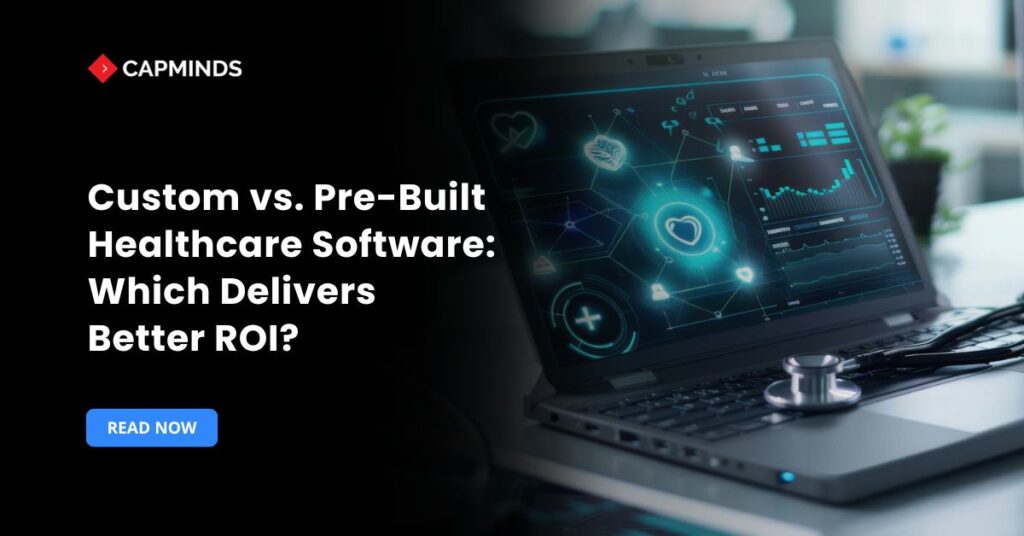Custom vs. Pre-Built Healthcare Software: Which Delivers Better ROI?
When investing in technology, healthcare organizations now have to make a crucial decision: should they purchase pre-built (off-the-shelf) software or create custom software to meet their needs? There are significant financial ramifications to this choice. Hospital administrators, CIOs, CTOs, and IT decision-makers must carefully consider the return on investment (ROI) of custom vs. pre-built software because the worldwide healthcare IT market is expected to exceed $1.8 trillion by 2030.
This article will compare these two strategies solely from a financial return on investment (ROI) standpoint, emphasizing upfront and ongoing expenses, total cost of ownership (TCO), deployment schedule, scalability, maintenance, and support.
Custom vs. Pre-built Software: Definitions and Characteristics
- Custom healthcare software: A custom solution is created especially to satisfy the particular needs and workflows of a business, either internally or through a development partner. The generated software is owned by the organization and is subject to unrestricted modification. Custom systems are created from the ground up (or significantly altered from a base platform) to meet specific requirements that may not be met by off-the-shelf products.
- Pre-built (off-the-shelf) healthcare software: A ready-made, commercially available software product intended for widespread use across numerous businesses is known as an off-the-shelf solution. These include popular vendor packages with common features and setups, including practice management, telehealth platforms, and electronic health records (EHRs). They are deployed much faster since you configure existing functionality instead of coding from scratch.
Critical healthcare procedures can be powered by either approach, but their ROI profiles and cost structures are very different.
Key Financial Factors Influencing ROI in Healthcare Software
1. Upfront vs. Long-Term Costs
Cost structure is one of the most obvious differences. While pre-built solutions disperse costs over time through subscriptions or licenses, custom software usually requires a significantly larger upfront expenditure.
- For instance, the initial cost of creating a custom healthcare application might vary from hundreds of thousands to millions of dollars (for example, $500,000 to $5 million for a complicated project).
- On the other hand, a lot of off-the-shelf healthcare systems charge either a per-user subscription (often $200–$500 per provider per month) or recurrent license costs, which can reach tens of thousands of dollars annually (for example, $50,000–$200,000 for licensing).
The total cost of ownership (TCO) over several years can actually favor custom solutions despite their upfront cost. Custom software has minimal per-user licensing costs after launch, while off-the-shelf fees accumulate. One company’s five-year TCO analysis revealed that, despite being more expensive at first, a custom solution “achieves cost parity by year three” and ends up being about 30–40% less expensive over five years than off-the-shelf because of the latter’s rising costs.
A custom solution was estimated to cost around $6.4 million over five years in a hypothetical mid-sized healthcare provider scenario with 200 users, compared to about $7.2 million for an off-the-shelf system.
However, these averages assume the custom project stays on budget and the software’s benefits are realized as planned. If a custom project runs over budget (not uncommon), the financial breakeven point is delayed. Off-the-shelf costs are more predictable early on – you know the subscription or license pricing in advance. Analyzing your organization’s development and time horizon is necessary to determine which option delivers a better return on investment.
Custom builds are frequently more cost-effective if you want to use the software for many years and scale it up, while purchases may be more cost-effective for shorter-term requirements or smaller-scale deployments.
2. Implementation Time and Resource Investment
| Criteria | Pre-Built Software | Custom Software |
| Typical Implementation Timeline | 1–6 months | 6–18 months |
| Complex Project Timeline | A few weeks (for turnkey cloud solutions) | 12–24 months |
| Time to ROI | Fast – value realized early | Delayed – value realized after development |
| Opportunity Cost | Low | High–potential forfeiture of millions in savings/revenue |
| Technical Team Requirement | Low – vendor handles core development | High – requires developers, PMs, QA, possibly external partners |
| Internal Staffing Need | Moderate – 6–12 months for integration, training, and adoption | High – 9–12+ months of hands-on development and coordination |
| Estimated Cost (MVP) | Included in licensing/subscription | $750,000+ |
| Scope Creep Risk | Low | High–frequency changes increase timeline and cost |
| Project Overrun Rate | Lower (with experienced vendors) | Around 67% of healthcare IT projects face delays or budget overruns |
3. Scalability and Upgrade Costs
Scalability can significantly affect ROI. As your organization grows or your user base increases, the cost of an off-the-shelf solution tends to scale linearly with usage. Most commercial healthcare software is priced per user, per provider, or per transaction. For example, an EHR might charge a monthly fee per provider account – if you double your number of providers, your subscription costs roughly double as well. There may also be additional module or capacity fees as you expand. This scalable pricing is convenient for predictable budgeting initially, but it means you pay more as you get more value, potentially diminishing ROI at larger scales.
With custom software, scaling costs are more under your control. You invest upfront in the development; adding more users typically incurs only marginal hosting or support costs. There are no license fees for each new user – you own the software. If designed with a robust architecture, a custom system can handle growth by scaling infrastructure (servers, cloud resources) without requiring a proportional increase in development cost each time you add users. This is why custom solutions often become more cost-effective for larger enterprises or over longer horizons. However, scalability isn’t just about cost – it’s also about technical limits. Off-the-shelf solutions may have limited feature sets or vendor-imposed restrictions that limit new use cases. You could have to pay for expensive upgrades or even switch to a new system if your needs exceed the capabilities of the product.
4. Maintenance and Support Implications
Ongoing maintenance is a significant part of software TCO that impacts ROI. With pre-built software, maintenance (bug fixes, security patches, server uptime, etc.) is largely handled by the vendor as part of your annual fees. You’re essentially outsourcing the maintenance burden. The subscription or support contract you pay for covers keeping the software up-to-date with regulatory requirements and technological updates.
In contrast, custom software requires you to budget for maintenance and support continuously. A common rule of thumb is to allocate 15–25% of the initial development cost per year for ongoing maintenance of custom software. This covers activities like fixing bugs, optimizing performance, applying security updates, and handling minor feature requests – essentially, the cost “just to keep the lights on”. If you spent $1 million building a system, expect around $150k–$250k per year in upkeep costs to maintain its value. This can be lower or higher depending on how complex the software is and how frequently you need to update it, but the key point is that maintenance is a significant, recurring expense for custom solutions.
Related: Strategic Investment in Custom Healthcare Software: A Guide for Hospital CIOs and CTOs
Financial Strengths and Drawbacks of Each Approach
There are clear cost benefits and drawbacks to both off-the-shelf and custom healthcare software. The ROI-related benefits and drawbacks of each choice are shown side by side below:
1. Custom Software – Key Financial Advantages:
- Tailored efficiency: Custom solutions can be optimized to your exact workflows, potentially yielding greater efficiency and cost savings in operations (for example, a custom OR scheduling system reduced operating room idle time by 23% at one hospital)hyscaler.com. This alignment with unique processes can translate to financial benefits that generic systems might miss.
- Long-term cost control: Custom development removes continuing license fees, despite the large initial expenditure. You gain more control by avoiding annual price increases and vendor lock-in. A well-scoped custom system may end up being less expensive than paying for subscriptions over a number of years (e.g., five or more years), particularly if user numbers increase and off-the-shelf alternatives’ license prices rise.
- Scalability and asset value: A custom platform can be scaled up without proportional cost increases. Adding users doesn’t dramatically increase costs, improving per-user ROI as you grow. You also own the intellectual property – the software itself can be considered a long-term asset that adds value to the organization (and can be adapted or even repurposed in the future without vendor restrictions).
2. Custom Software – Key Financial Challenges:
- High upfront cost: Before any value is gained, custom creation necessitates a substantial financial investment (often in the hundreds of thousands or millions for healthcare applications). Budgets may be strained, and long-term repayment must be trusted.
- Delayed ROI: Time-to-value is delayed due to the long development timeline (perhaps 6–18+ months). Until the system is implemented and widely used, the company must pay months’ worth of development expenses with no return on investment.
- Ongoing maintenance burden: All updates and support costs fall on you. Plan on ~15–25% of the build cost per year in maintenance expenses. Unforeseen needs or scope changes can further drive up costs; many custom projects face scope creep or overruns that impact the expected ROI.
- Risk and expertise requirements: The success (and financial return) of custom projects depends on having the right development talent and project management. If the project fails to meet requirements or runs significantly over budget, ROI can suffer. There’s also a higher opportunity cost – resources spent building software are not spent on other initiatives that might have an immediate impact.
3. Pre-Built Software – Key Financial Advantages:
- Lower initial cost & fast deployment: You usually pay a modest initial charge (plus integration services) for a pre-built system, followed by monthly or annual fees. Because of the quick deployment (usually in a matter of weeks or months) and lower initial investment, you can start reaping the benefits and returns much sooner.
- Predictable ongoing expenses: Pricing for subscriptions is typically clear and might be considered an operational expense. This predictability helps budgeting. For example, you might pay a fixed rate per user per month – easily scalable and known in advance. There’s no large capital spike as with a custom build.
- Vendor-provided maintenance and innovation: The vendor handles updates, maintenance, and improvements as part of your contract. You essentially outsource R&D and support. Because you share the development and compliance costs with numerous other clients and don’t have to continuously support a complete development team, this might be financially advantageous.
- Proven solution (lower risk): There is less chance of experiencing expensive failures or surprises because well-known off-the-shelf solutions have been tried and tested by several enterprises. Their capacity to manage heavy workloads is shown by the fact that Epic’s EHR platform serves more than 300 million patients worldwide. This can protect your ROI by avoiding the hidden costs of software bugs or downtime that a new custom system might experience.
4. Pre-Built Software – Key Financial Challenges:
- Accumulating long-term costs: Though there’s no huge upfront payment, the ongoing license or subscription fees add up over time. In a multi-year analysis, the total cost for an off-the-shelf solution often exceeds a comparable custom solution if the latter’s upfront cost is amortized.
- Limited fit (potential inefficiencies): The procedures used by your company may not be entirely compatible with an out-of-the-box solution. Workflow inefficiencies may result from a lack of customisation; employees may need to spend more time finding workarounds, or you may need to modify your procedures to fit the program. In fact, substantial workflow disruptions necessitating workarounds are reported by 43% of companies utilizing off-the-shelf EHRs. Staff time and lost productivity are costs associated with those inefficiencies.
- Scaling and flexibility costs: As your demands change, you may need to upgrade to more expensive service tiers or buy extra modules in order to obtain new capabilities, which can be costly. You may eventually have to make an expensive switch to a new system if your expansion exceeds the software’s design. You’re essentially at the mercy of the vendor’s product roadmap – if they don’t develop a feature you need, you may have to pay for third-party add-ons or live without it.
- Vendor dependency and lock-in: Relying on a vendor means you have less control over certain costs and technical decisions. You could feel “locked in” even if prices or services alter negatively because switching to a different product is frequently challenging and expensive. Additionally, you rely on the stability and priorities of the vendor; your investment may be impacted if they cancel the product or alter the conditions. This dependency introduces some long-term financial risk outside your direct control.
CapMinds Custom EHR/EMR Development Solution
CapMinds offers a comprehensive solution designed to create custom EHR/EMR tailored to meet your healthcare practice’s unique requirements.
We are a team of seasoned professionals with extensive expertise in healthcare technology.
CapMinds’ custom EHR/EMR development services address the specific needs and challenges of healthcare providers across specialties.
- CapMinds develops EHR applications with intuitive interfaces and workflows that align with your practice, ensuring seamless navigation and enhanced efficiency.
- Our solutions include creating robust custom modules for scheduling, patient management, documentation, and reporting, designed to improve operational workflows.
- We also specialize in integrating advanced features such as e-prescriptions, telehealth capabilities, and remote patient monitoring into your custom EHR application.
- Our experts provide end-to-end solutions, including data migration, interoperability, and compliance with healthcare standards like HL7 and FHIR.
- With a focus on security and scalability, our applications are built to support growth while safeguarding sensitive patient data.
Whether you’re looking to build a tailored solution from scratch or need to enhance your current system, CapMinds’ Custom EHR/EMR Development Solution is your trusted partner.
Contact us today to transform your vision into a fully functional, cost-effective EHR application that empowers your healthcare practice to succeed.




